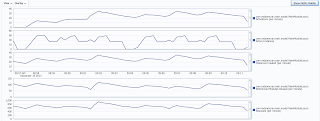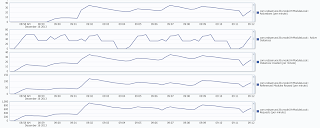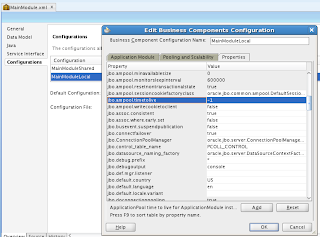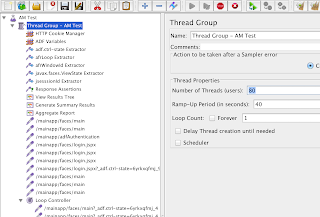This post is to describe such use case, where we have a set of common Entity Objects and want to handle View Objects and UI dynamically. This is common use case for simpler screens, usually common Entity Objects are provided from the library, but instead of creating hundreds of similar View Objects and UI fragments - we can handle such screens in generic way, by creating View Object instances programmatically and later using them through dynamic iterator.
Sample application - ADFDynamicReportUI_v3.zip is based on my previous post - ADF Generator for Dynamic ADF BC and ADF UI - Recreate. This sample is utilising ADF BC API for ViewDefImpl, VO instances are created and registered on the fly using this API.
There are two EO's created in the sample application:
Custom method is defined in Application Module implementation class - constructVOInstance, this method is used to create VO instances programmatically:
Here you can see how VO instances are created and registered:
We pass as a parameter - EO name, based on this name for VO is constructed. We check if VO with the same name already is registered, if not - VO will be created from EO. There is no need to set attributes one by one for VO, we can get all attributes directly from EO. SQL statement is created by API, based on EO information. Finally - create VO instance, based on VO definition, this will expose it to the Data Control and we could access it later on runtime from bindings. VO name is returned by the method, this is used later in the page definition to supply dynamic reference to the iterator.
Dynamic reference of the VO instance is defined in the page definition, I'm getting it from Page Flow Scope (initialized through Method Call activity calling dynamic VO construction method):
UI table is rendered with the help of ADF dynamic table component, this is pretty easy part:
Before actual UI fragment with the table is opened, we call Method Call activity and invoke dynamic VO construction method exposed through AM client interface - this allows to prepare current VO instance based on passed EO name parameter:
EO name parameter is defined as required on the task flow level, rendering UI fragment with dynamic table:
For the test purposes, I have created simple main page and passing parameters for Employees and Departments having two different regions. In real use cases, this can be changed by loading the same region and passing different EO name from menu model:
Here what we can see on UI - first tab brings dynamic VO instance for Employees:
Second tab brings another dynamic VO instance, reusing the same UI - this time for Departments:
Sample application - ADFDynamicReportUI_v3.zip is based on my previous post - ADF Generator for Dynamic ADF BC and ADF UI - Recreate. This sample is utilising ADF BC API for ViewDefImpl, VO instances are created and registered on the fly using this API.
There are two EO's created in the sample application:
Custom method is defined in Application Module implementation class - constructVOInstance, this method is used to create VO instances programmatically:
Here you can see how VO instances are created and registered:
We pass as a parameter - EO name, based on this name for VO is constructed. We check if VO with the same name already is registered, if not - VO will be created from EO. There is no need to set attributes one by one for VO, we can get all attributes directly from EO. SQL statement is created by API, based on EO information. Finally - create VO instance, based on VO definition, this will expose it to the Data Control and we could access it later on runtime from bindings. VO name is returned by the method, this is used later in the page definition to supply dynamic reference to the iterator.
Dynamic reference of the VO instance is defined in the page definition, I'm getting it from Page Flow Scope (initialized through Method Call activity calling dynamic VO construction method):
UI table is rendered with the help of ADF dynamic table component, this is pretty easy part:
Before actual UI fragment with the table is opened, we call Method Call activity and invoke dynamic VO construction method exposed through AM client interface - this allows to prepare current VO instance based on passed EO name parameter:
EO name parameter is defined as required on the task flow level, rendering UI fragment with dynamic table:
For the test purposes, I have created simple main page and passing parameters for Employees and Departments having two different regions. In real use cases, this can be changed by loading the same region and passing different EO name from menu model:
Here what we can see on UI - first tab brings dynamic VO instance for Employees:
Second tab brings another dynamic VO instance, reusing the same UI - this time for Departments:

















































































































































































